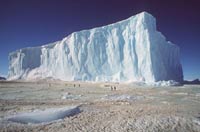|
|

|
|
Scientists unveiled on Sunday the first direct evidence that massive floods deep below Antarctica's ice cover are accelerating the flow of glaciers into the sea.
|
Scientists unveiled on Sunday the first direct evidence that massive floods deep below Antarctica's ice cover are accelerating the flow of glaciers into the sea.
How quickly these huge bodies of ice slide off the Antarctic and Greenland land masses into the ocean help determine the speed at which sea levels rise.
The stakes are enormous: An increase measured in tens of centimeters could wreak havoc for hundreds of millions of people living in low-lying deltas and island nations around the world.
Researchers discovered only recently that inaccessible subglacial lakes in Antarctica periodically shed huge quantities of water.
Data collected by a satellite launched in 2003 - the Ice, Cloud and Land Elevation Satellite, or ICESat - revealed a complex network of subglacial plumbing in which water periodically cascades from one hidden reservoir to another.
But the new study, published online in the journal Nature Geoscience, is the first to measure the potential impact of this invisible flooding on sea-bound glaciers.
A trio of scientists led by Leigh Stearns of the Climate Change Institute at the University of Maine matched ICESat data against a nearly 50-year record of how fast the Byrd Glacier in East Antarctica has moved toward the sea.
They discovered that during the same 14-month period that 1.7 cubic km of water cascaded through subglacial waterways, the 75-km long glacier downstream pick up speed, moving about 10 percent faster.
"Our findings provide direct evidence that an active lake drainage system can cause large and rapid changes in glacier dynamics," the researchers concluded.
"Water acts as a lubricant, reducing friction at the base of the ice and making ice flow faster," explained Helen Fricker of the Scripps Institution of Oceanography of California in a commentary, also in Nature Geoscience.
The study adds to growing scientific concern about the pace at which glaciers are melting into the seas.
点击查看更多双语新闻
(Agencies)
|
科学家于上周日首次公布资料,证明南极冰层下的大规模水流正加速冰川流向海洋。
这些体积庞大的冰川正从南极大陆和格陵兰岛漂向海洋,它们漂移的速度直接决定了海平面升高的速度。
这导致的后果将触目惊心:海平面升高几十厘米就足以威胁居住在地势较低的三角洲及岛国地区的亿万人民的生存。
研究人员最近发现,南极冰层下隐秘的湖泊会发生周期性的倾泻。
美国宇航局2003年发射的“冰云和地面高度卫星”(ICESat)收集的数据显示,南极冰层下有一个复杂的湖泊排水网络,湖水会周期性地从一个隐秘的湖泊流向另一个湖泊。
而这项最新研究则首次估量了海洋冰川下隐秘水流的潜在影响。该研究成果在《自然地学》期刊的网络版上发表。
以美国缅因州大学气候变化学院的斯特恩斯为首的三位科学家将卫星数据与南极东部的伯德冰川在过去近50年中移向海洋的速度进行了对比。
通过比较,研究人员发现,在14个月的时间中,冰层下湖泊溢出了1.7立方千米的水,75公里长的伯德冰川的移动速度加快了10%。
研究人员由此得出结论:“活跃的湖泊排水系统会导致冰川运动出现大规模、快速的变化,我们的研究结果为此提供了直接证据。”
加州斯克里普斯海洋学研究所的海伦•弗里克在一篇科学评论中解释说:“水可起到润滑剂的作用,减少了冰层底部的摩擦,所以加速了冰川的流动。”她的这篇文章也在《自然地学》期刊上发表。
该研究进一步加剧了科学家对冰川融化速度的担忧。
(实习生许雅宁 英语点津姗姗编辑)
|